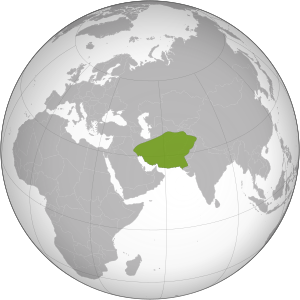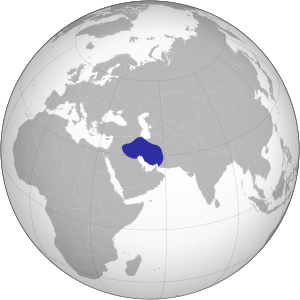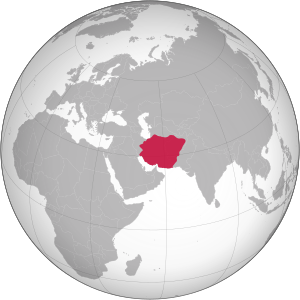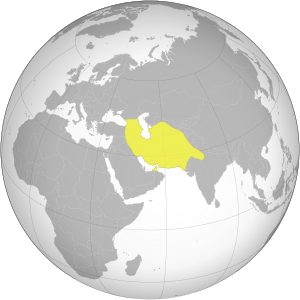User:Aryzad/sandbox
Persian Empire Aryānām Xšaθra (Old Persian)
Ērānšahr (Middle Persian) Šāhanšāhiye Irān (New Persian) "The Iranian Empire" | |
|---|---|
| 550 BC–1979 AD 550 BC–330 BC (First dynasty) 1925 AD –1979 AD (Last dynasty) | |
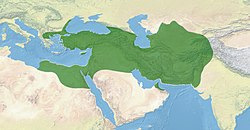 The Persian Empire under rule of Darius I, at its greatest extent. | |
| Capital | |
| Common languages |
|
| Religion |
|
| Government | absolute monarchy, constitutional monarchy (after 1906) |
| Shahanshah (King of Kings) | |
• 559 BC – 530 BC | Cyrus the Great (first) |
• 522 BC–486 BC | Darius I |
• 121 BC–91 BCE | Mithradates II |
• 224 AD–242 AD | Ardashir I |
• 632 AD–651 AD | Yazdgerd III |
• 1502 AD–1524 AD | Ismail I |
• 1736 AD–1747 AD | Nader Shah |
• 1794 AD–1797 AD | Agha Mohammad Shah |
• 1941 AD–1979 AD | Mohammad Reza Pahlavi (last) |
| Historical era | Ancient world to 20th century |
| Area | |
| 480 BC | 8,000,000 km2 (3,100,000 sq mi) |
| 620 AD | 6,600,000 km2 (2,500,000 sq mi) |
| 1979 AD | 1,648,195 km2 (636,372 sq mi) |
| Currency | various |
The Persian Empire (Old Persian: Aryānām Xšaθra[1], Middle Persian: Ērānšahr, New Persian: Šāhanšāhiye Irān, lit. "The Iranian Empire") refers to the imperial history of Iran, from conquest of the Median state by Cyrus the Great in 550 BC until fall of the Pahlavi dynasty due to the Iranian revolution in 1979 AD. However, during this 2500 years-long history, the empire was sometimes interrupted by the lack of a central government or foreign occupation.
The history of the Persian Empire had two different periods, the Classical Persian Empire, from the unification of the Iranian world under Cyrus the Great until death of Yazdgerd III (550 BC–654 AD), and the Modern Persian Empire, from rise of Shah Ismail I until fall of Mohammad Reza Pahlavi (1501–1979). It can be argued that the Persian state wasn't an Empire in it's final decades; However Imperial Iran is traditionally known as the Persian Empire and the rulers assumed the title of Iranian emperors, "King of Kings".
Name
[edit]Common word in English language to refer pre-modern Iran is Persia, which comes from Greek word Persis, itself delivered from Old Persian Pārsa. Persia or Pārsa is a region in the south of Iran and today is known as Pars province. However, Iranians themselves never used this word to refer their country as a whole.
It is believed that the Achaemenids called their state "Xšaθra", which means "the Empire". The Proto-Iranian form of Iran is Aryānām, while Old Persian and Avestan forms are ariyanem and airyanəm, respectively. However, this word refers to a group of people, the Iranians, and not a geographical place. Middle Persian form is ērān and the Parthian form is aryān. All of these words (ariyanem, airyanəm, ērān and aryān) share the same meaning and all of them mean Iranians.
First usage of Iran (or one of it's cognates) as the name of the empire dates back to the time of Shapur I, who called his Empire ērānšahr. In his Res Gestae, Shapur I says:
I, the Mazda worshipping lord Shapur, shahanshah (king of kings) of ērān (Iranians) and anērān (non-Iranians)... am ruler of ērānšahr (Empire of Iranians).
— Shapur I, from Shapur I's inscription at the Ka'ba-ye Zartosht
Until fall of the Sassanian dynasty, ērānšahr was common and official name for the Persian Empire, but by fall the dynasty, ērān (and Irān after some times) slowly replaced ērānšahr.
The Persian Empire was divided to four regions by the Sassanian king of kings, Khosrow I, and every region was governed by a spahbed. This system wasn't changed during the rule of the Caliphates.
Titles of the rulers
[edit]Most common title for rulers of the Persian Empire was King of Kings, since every satrap was called King and the king of satraps was called King of Kings. Another title was Great King, which was more common in the Greco-Roman world to refer rulers of Iran. Like the king, the queen of Iran was called the Queen of Queens in ancient times.
Official title of the rulers of the medieval and modern times was still King of Kings. However, since there were no other king in the Empire, the ruler was simply called the King.
Persian word for king is Shah. This word is spelled Šāh in both Middle Persian and Modern Persian, and comes from Old Persian xšāyaθiya, which was originally an Avestan word, xšaϑra-, and literally means Power. It's female equivalent in Middle Persian is banbishn (literally: mistress), and probably māna-pashnī in Old Persian. Modern Persian word for Queen is Shahbanu (literally: king-lady, or king's lady). The King of Kings was called Šāhanšāh (shah of shahs) and the Queen of Queens was called bānbishnān bānbishn (bānbishn of bānbishns) in Persian.
New Persian word for Great King is Pādešāh.
Khwarenah
[edit]Khvarenah (Avestan: 'xᵛarənah', Persian: far literally: glory or splendour) is a Zoroastrian concept about divine kingship. In the Zoroastrian view and the Iranian world, it's necessary for the shananshahs to hold the khvarenah and if a king of kings rule unjustly and with cruelty, he would lose it.
Most famous time when a ruler lost khvarenah is when Jamshid, the greatest of the Pishdadians, lost the divine kingship. He ruled three hundred years and became "the greatest monarch the world had ever known", but his pride grew with his power so he started to forget that he is a mortal man. Jamshid asked the people to respect him as a god and the creator of the universe, and that caused him loss of khvarenah.
| History of Iran |
|---|
 The Gate of All Nations in Fars |
|
Timeline |
Political system
[edit]The Persian Empire had two different political systems during the classical and the modern periods.
Classical Persian Empire
[edit]In the ancient times,
History
[edit]Heroic Era
[edit]The Iranian history started in early 1st millennium BC, but according to the tradition history of Iran, it started 3400 years before rise of Ardashir. This era is generally called "The Heroic Era" by Iranologists, because it's about heroic deeds of great warriors of the Avesta and the Persian mythology like Kay Khosrow and Rustam.
Pishdadians
[edit]According to the Iranian mythology, Pishdadian dynasty (literally: first law-bringers) is the first dynasty that ruled over the Iranian lands. Early Pishdadian shahanshahs are seen as rulers of the whole world and some of them ruled for thousands of years.
Pishdadian dynasty is very important in tradition Iranian historiography, since Keyumars is seen as the first human, Hushang is the first law-bringer (Persian: Pishdad, Avestan: Paraδāta) and Iraj is seen as name-giver of Iran.
Kayanians
[edit]The Kayanian dynasty is the second Iranian dynasty of Iranian mythology. The word kay is Persian form of Avestan kavi and literally means King. The dynasty is seen as an idealistic dynasty among Iranians. Many Iranian shahanshahs were named after the Kayanian kings and some of them like Yazagerd I used title kay in their names. Kiani Crown is named after this dynasty and Imperial throne of Iran is usually referred as "taxt e kayan" or throne of kays. "We are the heirs of Kayanids" used to be part of Iranian national anthem.

Background
[edit]

Achaemenids
[edit]In 559 BC, Cyrus the Great succeeded his father Cambyses I as ruler of Anshan, a minor kingdom in south of Iran. Son after, Cyrus rebelled against the Great King, Astyages, who was also his grandfather. With the help of the Median elites, Cyrus successfully conquered Media and became the Great King. Two years later, he had Kingdom of Lydia under his control, and ten years after that, in 539 BC, he annexed Neo-Babylonian Empire to the Persian Empire, where he famously declared freedom of religion. Cyrus died in 530 BC, probably in his campaign against the Massagetae.
After death of Cyrus, his eldest son, Cambyses II became the King of Kings. Cambyses, who married his sisters Atossa and Roxana, invaded Egypt, as it was expected since Egypt was the last independent state in the Near East after conquest of the region by Cyrus, defeated Psamtik III and crowned as pharaoh of Egypt. He also invaded the Kingdom of Kush, however, with little success. When Cambyses was still in Egypt, the Iranian throne was seized in Persia, by his brother Bardiya or a magi who claimed he is Bardiya. Cambyses died in 522 BC, on his way back to Persia to reclaim the Achaemenid throne.
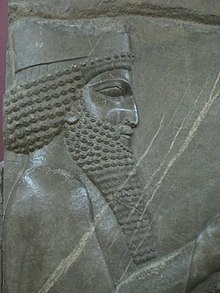
Arsacids
[edit]
In 247 BC, a Parni (a group of Eastern Iranian people) warlord, Arsaces I, conquered Parthia, a region in north-eastern Iran. This conquest is seen as start of the Arsacid dynasty, the ruling dynasty of the Parthian Empire.
Arsaces I ruled until 217 BC, when he died and was succeeded by his son Arsaces II. All of the Parthian rulers were named Arsaces, and the dynasty was called Arsacid dynasty, because he was seen as a heroic figure by his descendant. However, while Arsaces I was a capable ruler, the Parthian state needed few more decades to become an Empire.
Conquest of Iran
[edit]In 171 BC, Mithridates I succeeded his brother Phraates I and assumed ancient title of the King of Kings and became the first ruler in the history of the Arsacid dynasty who crowned with this title.
Mithradates I, the first of the Arsacids who is regarded as "the Great", started his conquests in 150s BC, first invaded Greco-Bactrian kingdom, defeated them and seized Bactria (modern-day Balkh in Afghanistan). Then he invaded the Seleucid Empire and conquered Media in 148 BC. By 141 BC, he had all of Iranian territories of Seleucid Empire under his control. The Seleucids tries to reconquer these lost lands in the last years of Mithradates I reign and early years of his son, Phraates II, but they were decisively defeated by the Arsacids.
Wars in the East
[edit]Wars with Rome
[edit]Roman-Iranian relations were established in 96 BC, when Mithradates II, the second of the Arsacids who is regarded as "the Great", was on the Parthian throne. Some minor military clashes took place in 69 BCE, but it was in 53 BC when the first great war happened between the two powers.
Marcus Licinius Crassus, one of the first triumvirate, invaded the Parthian Empire in 53 BC for wealth and glory. He faced the Arsacids, who had Surena of house of Suren as their leader, in the deserts of Mesopotamia, near Carrhae. But the Romans were slaughtered by a heavily outnumbered Parthian army. It was said the Romans lost 30,000 men, while the Parthians only lost 38 cataphracts. Crassus himself was killed by Surena, who sent his head to the Parthian king of kings, Orodes. Rome was humiliated by this defeat, and they lost several Legionary Eagles, which made it even worse. Crassus's death ended first triumvirate and played an important role in the fall of the Roman Republic and rise of the Roman Empire.
During the Caesar's civil war, the Arsacids sided with Pompey, but he lost the civil war. Caesar was elected as Rome's lifetime dictator by the senate and he started to prepare to invade the Parthian Empire to avenge Crassus and Battle of Carrhae, but he was assassinated by the senators. Then the Parthians invaded Syria and Anatolia but the Romans successfully repelled them. Another massive war happened between the two states when Mark Antony invaded Parthia, this time the Parthians were the victors and the Romans lost 32,000 men. A peace was signed by Phraates and Augustus in 20 BC, and ended first series of Roman-Iranian wars.
In early years of first millennium AD, another series of Roman-Parthian wars started, this time for influence in Armenia. The Arsacids wanted to place an Iranian prince on the Armenian throne and this caused military clashes between the two states. Under shahanshah Phraataces and queen of queens Musa, the Parthians tried to install one of their own on the throne of Armenia, but gained no success. Again in 35 AD, Artabanus III tried to establish his son, Arsaces, as king of Armenia, but with civil war in his empire, he failed. But under Vologases I the Parthians gained what they wanted. Vologases invaded Armenia and installed his brother, Tiridates, as king there. But when he was in the east to secure the eastern borders of his empire, the Romans, under Nero, attacked Armenia, deposed Tiridates and replaced him with a Cappadocian prince. But when Vologases secured the eastern borders of the Parthian Empire, he invaded Armenia one more time, and decisively defeated the Romans in Tigranocerta and Rhandeia. After this battled, the Romans agreed to allow a branch of the Parthian princes to rule Armenia on condition that they received the kingship from the Roman emperor. However, In the judgment of later Roman generations, "Nero had lost Armenia".
Sassanids
[edit]
Papak, father of Ardashir I, was one of minor kings of Pars (or Persia, a region in south-western Iran) during late Arsacid era. However, with the help of his eldest son Shapur, he was master of all of Pars in the year 200. What happened next is uncertain, but it is known that after death of Papak, a struggle for power started between Shapur and Ardashir.
According to the ancient sources, Shapur was killed when the roof of a building collapsed on him, when he was on the way to see his brother Ardashir. This event, made Ardashir the sole ruler of Pars in 208, end opened the way for the rise of the Sassanian Empire. After that, Ardashir extended his territory, and this made war between the Arsacids and the Sassanids unavoidable. In 224, Artabanus V, the last shahanshah of the Parthian Empire, ordered to governor of Khuzestan to wage a war against Ardashir, but the new Sassanian king of kings decisively defeated him. This time, Artabanus himself met Ardashir in plains of Hormozdgan, but Ardashir was victorious again, and the Parthian shah was killed in the battle. Then Ardashir marched to Ctesiphon and crowned as the King of Kings of Iranians in 224. Four years latter, he killed the last of Arsacids, Vologases VI and became the sole ruler of Iran.
Arab occupation, the Islamic Golden Age, Mongol occupation and Post-Ilkhanate period
[edit]Arab occupation
[edit]Islamic Golden Age
[edit]The Islamic Golden Age saw rise of many native Iranian dynasties, including Tahirids, Saffarids, Samanids, Buyids, Ziyarids and Ghurids. However, none of them unified Iranian lands under a single rule and none of their rulers crowned as Shahanshah of Iran, so they are not considered as Persian Empires.
This era is known as Iranian Intermezzo, and is important since the Iranian national spirit and culture revived in this period in an Islamic form.
-
Saffarid dynasty at its greatest extent
-
Samanid dynasty at its greatest extent
-
Buyid dynasty at its greatest extent
Mongol occupation
[edit]Post-Ilkhanate Period
[edit]Safavids, reunification of Iran and rebirth of the Persian Empire
[edit]
The Safavid Empire was the first Iranian state that rule all of Iranian lands after the fall of the Sassanids. This period is generally seen as rebirth the Persian Empire and start of modern history of Iran. It was established by Shah Ismail I, who proclaimed himself Shahanshah of Iran after conquest of Tabriz.
The Safavids, ruled from 1501 until fall of Isfahan in 1722, declared Shia Islam as official religion of Iran. The conversion of Iran from Sunni to Shia is seen as one of most important events in history of Iran and history of Islam.
Hotakis, Afshars and Zands
[edit]Hotakis
[edit]Afshars
[edit]After years of struggle between the Safavids, the Hotaks, the Ottomans, the Russians and some other local war-lords over control of Iranian lands, finally Nader Shah conquered Iran and reestablished the Persian Empire. Nader's reign saw a series of conflicts with neighbors of Iran, including the Mughals of India and the Ottomans, known as Naderi Wars.
However, Nader Shah's vast empire soon fell apart right after his death, which started a new series of civil wars in Iran.
Zands
[edit]After fall of Nader's Empire, another series of civil wars started in Iran. The eastern parts of Afsharid Empire was conquered by Ahmad Shah Durrani, one of Nader's spahbeds, while Khorasan remained under rule of Nader Shah's successors. The western parts, however, was conquered by Karim Khan Zand, another spahbed of Nader Shah.

Karim Khan refused the regular title of shahanshah and ruled as Deputy of the People. His reign is seen as an era of peace in Iran, but right after his death, civil war started in Iran once again, between the Zand princes.
After a decade of civil wars, Lotf Ali Khan, a Zand prince, came to power in 1789. However, while Zand civil war was ended, another series of civil wars started between Zands and Qajars.
-
Hotak dynasty at its greatest extent
-
Afsharid dynasty at its greatest extent under Nader Shah
-
Zand dynasty at its greatest extent

Qajars
[edit]In 1796, after fall of Zand and Afsharid dynasties, Agha Mohammad Khan of Qajar dynasty was the sole ruler of Iran. But soon after, in 1797, he was assassinated by his servants. Since he had no children, the shah was succeeded by his nephew, Fath-Ali Shah.
Reign of Fath-Ali Shah saw huge and irrecoverable territorial loss for the Persian Empire after wars against the Russians in 1804–13 and 1826–28. Fath-Ali died in 1834 and was succeeded by his grandson, Mohammad Shah.
During his short reign, Mohammad Shah tried to modernize the Iranian army and recapture Herat. However, his attempts were unsuccessful. He died at the age of 40 in Mohammadieh Palace in 1848.
After death of the Mohammad Shah, his son, Naser al-Din Shah, ascended to the Sun Throne. He ruled for 50 years, and became the third longest reigning monarch in Iranian history after Shapur II and Tahmasp I. Many events took place during his long reign, including wars with the British Empire and rebellion of Babis, the assassination of Amir Kabir and Tobacco Protest.
After the assassination of Naser al-Din Shah, Mozaffar ad-Din Shah ascened to the throne. The first Iranian revolution, the Constitutional Revolution, took place in his reign. Mozaffar ad-Din Shah was the last shah who died in Iran.
Mohammad Ali Shah Qajar succeeded his father in 1907. He dissolved the parliament and declared the Constitution abolished and bombarded the Majles. However, he abdicated after the Triumph of Tehran by pro-Constitution forces and re-establishment of the constitution.
Following the abdication of the shah in 1909, the Majlis placed his 6-years-old son, Ahmad Shah on the Iranian throne. The World War I took place during his reign and Iran declared neutrality. However, it didn't stopped the British forces and they occupied many parts of Iran, which caused the Great famine of 1917–1919 and death of 2 million Iranians.
With 1921 Persian coup d'état Reza Pahlavi took control of the country. Ahmad Shah left Iran for Europe for health reasons In 1923 and with the official end of Qajar dynasty in 1925 and rise of Pahlavi dynasty, his tour became an exile. He died in 1930 in Paris.
Pahlavis
[edit]
The Pahlavi dynasty (literally: Parthian dynasty), founded by Reza Shah, was last imperial dynasty of the Persian Empire. Started in 1925, the Pahlavis would rule the Imperial State of Iran until 1979, when the Persian monarchy was ended by the Iranian revolution.
Reza Shah
[edit]Early Years
[edit]Reza Shah was born in 1878, in Mazandaran. His father was Major Abbas-Ali Khan and his mother was Noush-Afrin. When he was 8 months old, his father died so he and his mother and brother moved to Tehran. In 1894, when he was 16 yeas old, he joined Persian Cossack Brigade and by 1915, he was a colonel.

Mohammad Reza Shah
[edit]Early Years
[edit]The Revolution and end of the Persian monarchy
[edit]Languages
[edit]Official language and lingua franca of the Achaemenid Empire was Aramaic language, while since the dynasty was originally from Persis, Old Persian was language of the elites and the royal family. However, since the Old Iranian languages were mutually intelligible, Old Persian was used by the state in the imperial inscriptions.
After the Greek conquest of Iran by Alexander the Great, the Greek language started to spread around the near east.
Religions
[edit]Achaemenids
[edit]The Religion of the Achaemenids is debated, but it was definitely related to the Zoroastrianism. It could be either early form of the Zoroastrianism or influenced by Zoroastrianism. However, many people of the Achaemenid royal family were named after the Zoroastrian heroes, like Darius I's father (Vištāspa), named after Kavi Vištāspa, Cyrus the Great's daughter (Atossa, Greek form of Iranian name Hutaosā), named after Hutaosā, queen of Kavi Vištāspa, and grandson of Darius, Pišišyaoθna, named after son of Kavi Vištāspa.
The Achaemenids were known for their tolerance of the other religions. After conquest of Babylon, Cyrus the Great granted freedom of worship for his subjects and rebuilt the ruined temples.
Arsacids
[edit]The Religion of Parnis before conquest of Parthia is uncertain, but it was essentially the ancient Iranian polytheism, related or influenced by Zoroastrianism. However, some evidences proves that the Arsacids were Zoroastrian, evidences like close-kin marriage (xwēdōdah), among both the royal family and the ordinary people. One of the Parthian rulers, Vologases, probably Vologases I, is praised in the Zoroastrian tradition for taking measures to preserve "in each province whatever had survived in purity of the Avesta and Zand, as well as every teaching derived from it... whether written or in oral transmission."[2]
Sassanids
[edit]The Zoroastrianism was the state religion of the Sassanian Empire. This era is known as the golden age of the Zoroastrianism, since the state supported this religion. However, with spread of other religions in Iran, like Manichaeism, Mazdakism, Christianity and Buddhism, clash of the religions was unavoidable.
Manichaeism
[edit]Mazdakism
[edit]Christianity
[edit]Sunni Islam
[edit]Safavids
[edit]After reunification of Iran under Safavid rule, the new dynasty started to convert the people to Shia Islam. The conversion, however, took place with brutal methods. It was reported that the Safavid shahanshahs, Shah Ismail and Shah Abbas in particular, despised the Sunnis so much.
Afshars
[edit]Nader Shah on the other hand, who was probably irreligion himself, was known for his tolerance. While on the day of his coronation, he officially declared that Iran is Sunni country again, he respected holy sites of Shias; After conquest of Mashhad, he repaired the shrine of Imam Reza and expanded the site. He also ordered for translation of holy books the Jews and Christians to Persian.
Qajars
[edit]Pahlavis
[edit]Society
[edit]
Architecture
[edit]Parsian style
[edit]Parthian style
[edit]Azeri style
[edit]Isfahani style
[edit]Art
[edit]Foreign Relations
[edit]See also
[edit]References
[edit]- ^ The equivalent of ērānšahr does not appear in Old Persian but it would have been *aryānām xšaθra
- ^ "ARSACIDS iv. Arsacid religion – Encyclopaedia Iranica". www.iranicaonline.org. Retrieved 2019-04-06.



